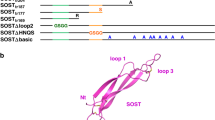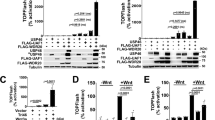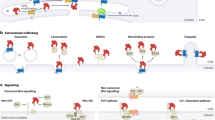Abstract
Wnt genes comprise a large family of secreted polypeptides that are expressed in spatially and tissue-restricted patterns during vertebrate embryonic development1. Mutational analysis in mice has shown the importance of Wnts in controlling diverse developmental processes such as patterning of the body axis, central nervous system and limbs, and the regulation of inductive events during organogenesis2. Although many components of the Wnt signalling pathway have been identified, little is known about how Wnts and their cognate Frizzled receptors signal to downstream effector molecules. Here we present evidence that a new member of the low-density lipoprotein (LDL)-receptor-related protein family, LRP6 (ref. 3), is critical for Wnt signalling in mice. Embryos homozygous for an insertion mutation in the LRP6 gene exhibit developmental defects that are a striking composite of those caused by mutations in individual Wnt genes. Furthermore, we show a genetic enhancement of a Wnt mutant phenotype in mice lacking one functional copy of LRP6. Together, our results support a broad role for LRP6 in the transduction of several Wnt signals in mammals.
This is a preview of subscription content, access via your institution
Access options
Subscribe to this journal
Receive 51 print issues and online access
$199.00 per year
only $3.90 per issue
Buy this article
- Purchase on Springer Link
- Instant access to full article PDF
Prices may be subject to local taxes which are calculated during checkout





Similar content being viewed by others
References
Wodarz, A. & Nusse, R. Mechanisms of Wnt signalling in development. Annu. Rev. Cell Dev. Biol. 14, 59– 89 (1998).
Uusitalo, M., Heikkila, M. & Vainio, S. Molecular genetic studies of Wnt signalling in the mouse. Exp. Cell Res. 253, 336– 348 (1999).
Brown, S. D. et al. Isolation and characterization of LRP6, a novel member of the low density lipoprotein receptor gene family. Biochem. Biophys. Res. Comm. 248, 879–888 (1998).
Skarnes, W. C., Moss, J. E., Hurtley, S. M. & Beddington, R. S. P. Capturing genes encoding membrane and secreted proteins important for mouse development. Proc. Natl Acad. Sci. USA 92, 6592–6596 (1995).
Takada, S. et al.Wnt-3a regulates somite and tailbud formation in the mouse embryo. Genes Dev. 8, 174–189 (1994).
Yoshikawa, Y., Fujimori, T., McMahon, A. P. & Takada, S. Evidence that absence of Wnt-3a signalling promotes neuralization instead of paraxial mesoderm development in the mouse. Dev. Biol. 183, 234–242 (1997).
Greco, T. L. et al. Analysis of the vestigial tail mutation demonstrates that Wnt-3a gene dosage regulates mouse axial development. Genes Dev. 10, 313–324 ( 1996).
McMahon, A. P. & Bradley, A. The Wnt-1 (int-1) proto-oncogene is required for development of a large region of the mouse brain. Cell 62, 1073–1085 ( 1990).
Thomas, K. R. & Capecchi, M. R. Targeted disruption of the murine int-1 proto-oncogene resulting in severe abnormalities in midbrain and cerebellar development. Nature 346, 847– 850 (1990).
Thomas, K. R., Musci, T. S., Neumann, P. E. & Capecchi, M. R. Swaying is a mutant allele of the proto-oncogene Wnt-1. Cell 67, 969–976 ( 1991).
Bally-Cuif, L., Cholley, B. & Wassef, M. Involvement of Wnt-1 in the formation of the mes/metencephalic boundary. Mech. Dev. 53, 23– 34 (1995).
Parr, B. A. & McMahon, A. P. Dorsalizing signal Wnt-7a required for normal polarity of D–V and A–P axes of mouse limb. Nature 374, 350–353 ( 1995).
Yang, Y. & Niswander, L. Interaction between the signalling molecules WNT7a and SHH during vertebrate limb development: dorsal signals regulate anteroposterior patterning. Cell 80, 939–947.
Liu, P. et al. Requirement for Wnt3 in vertebrate axis formation. Nature Genet. 22, 361–365 ( 1999).
Yamaguchi, T. P., Bradley, A., McMahon, A. P. & Jones, S. A. Wnt5a pathway underlies outgrowth of mutiple structures in the vertebrate embryo. Development 126, 1211– 1223 (1999).
Hey, P. J. et al. Cloning of a novel member of the low-density lipoprotein receptor family. Gene 216, 103–111 (1998).
Wherli, M. et al. arrow encodes an LDL-receptor-related protein essential for Wingless signalling. Nature 407, 527 –530 (2000).
Tamai, K. et al. LDL receptor-related proteins in Wnt signal transduction. Nature (this issue).
Brown, M. S., Herz, J. & Goldstein, J. L. Calcium cages, acid baths and recycling receptors. Nature 388, 629–630 (1997).
Willnow, T. E. The low-density lipoprotein receptor gene family: multiple roles in lipid metabolism. J. Mol. Med. 77, 306– 315 (1999).
Trommsdorff, M. et al. Reeler/Disabled-like disruption of neuronal migration in knockout mice lacking the VLDL receptor and ApoE receptor 2. Cell 97, 689–701 (1999).
Townley, D. J., Avery, B. J., Rosen, B. & Skarnes, W. C. Rapid sequence analysis of gene trap integrations to generate a resource of insertional mutations in mice. Genome Res. 7, 293– 298 (1997).
Brennan, J. & Skarnes, W. C. in Methods in Molecular Biology, Molecular Embryology: Methods and Protocols Vol. 97 (eds Sharpe, P. & Mason, I.) 123–138 (Humana Press, Totowa, NJ, 1999).
Hogan, B., Beddington, R., Constantini, F. & Lacy, E. (eds) Manipulating the Mouse Embryo: A Laboratory Manual 2nd edn 260 –261 (Cold Spring Harbor Laboratory Press, Cold Spring Harbor, 1994).
Wilkinson, D. G. & Nieto, M. A. Detection of messenger RNA by in situ hybridization to tissue sections and whole mounts. Methods Enzymol. 225, 361– 367 (1993).
Acknowledgements
We wish to thank F. Hess for providing us with the mouse LRP5 and LRP6 cDNAs; V. Wilson, J. Rubenstein and T. Greco for helpful discussions; A. Peterson, J. Rine, G. Garriga and members of the lab for critical comments on the manuscript. This work was funded in part by the Biotechnology and Biological Sciences Research Council (UK), the Chicago Community Trust and a grant from the March of Dimes. W.C.S. is a 1998 Searle Scholar.
Author information
Authors and Affiliations
Rights and permissions
About this article
Cite this article
Pinson, K., Brennan, J., Monkley, S. et al. An LDL-receptor-related protein mediates Wnt signalling in mice. Nature 407, 535–538 (2000). https://doi.org/10.1038/35035124
Received:
Accepted:
Issue Date:
DOI: https://doi.org/10.1038/35035124
This article is cited by
-
Design, synthesis, and in silico studies of novel di-(2-aryl hydrozonopropanal) arene derivatives as potent anticancer for targeting A2AR and LRP6 in HCT116 cell
Medicinal Chemistry Research (2024)
-
Association between axial length and HDL in children: a hospital-based cross-sectional study
BMC Ophthalmology (2023)
-
LRP5-/6 gene polymorphisms and its association with risk of abnormal bone mass in postmenopausal women
Journal of Orthopaedic Surgery and Research (2023)
-
The WNT/β-catenin system in chronic kidney disease-mineral bone disorder syndrome
International Urology and Nephrology (2023)
-
lncRNA MEG3 Promotes Osteogenic Differentiation of Tendon Stem Cells Via the miR-129-5p/TCF4/β-Catenin Axis and thus Contributes to Trauma-Induced Heterotopic Ossification
Stem Cell Reviews and Reports (2023)
Comments
By submitting a comment you agree to abide by our Terms and Community Guidelines. If you find something abusive or that does not comply with our terms or guidelines please flag it as inappropriate.



